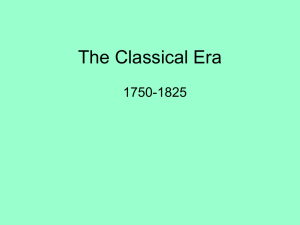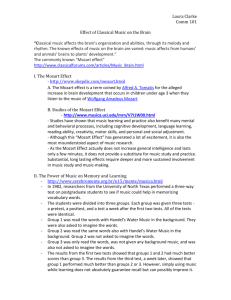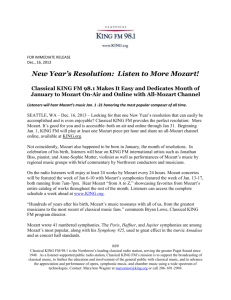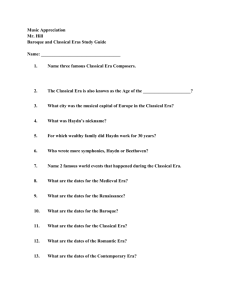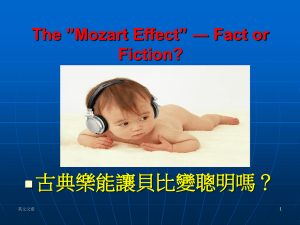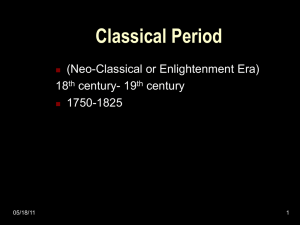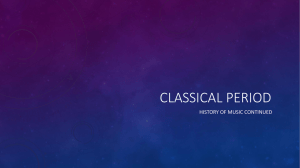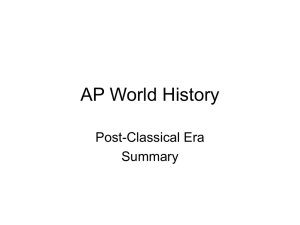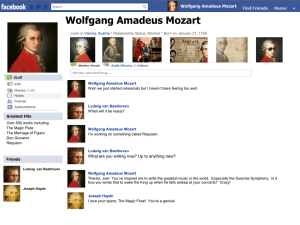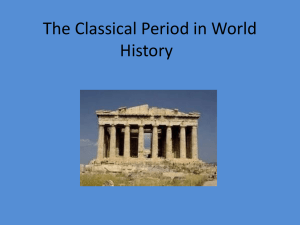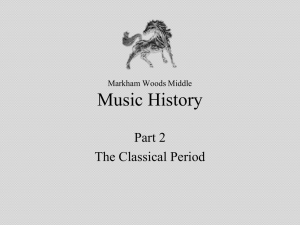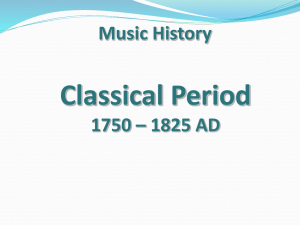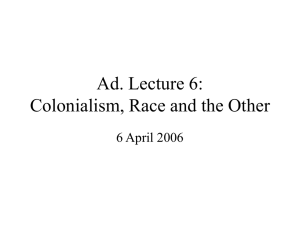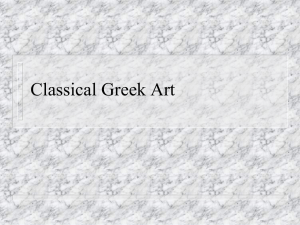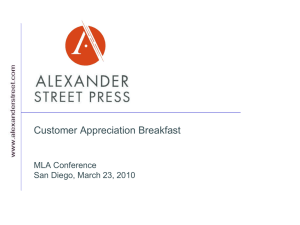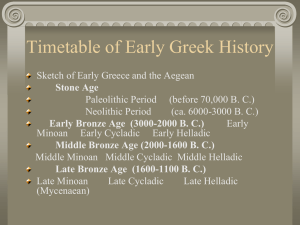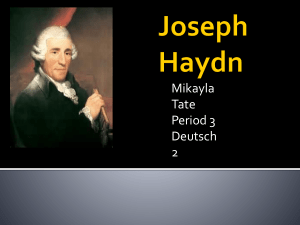The Classical Era 1750-1820
advertisement
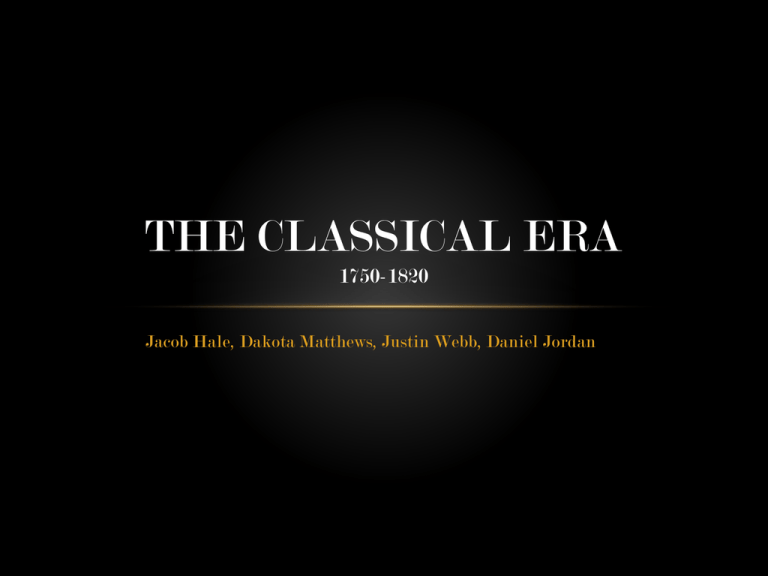
THE CLASSICAL ERA 1750-1820 Jacob Hale, Dakota Matthews, Justin Webb, Daniel Jordan INVENTIONS OF THE CLASSICAL ERA • 1760 - Industrial Revolution begins • 1763 - Watts invents the first steam powered engine • 1769 - Watt's steam engine patented • 1771 - First edition of the Encyclopedia Britannica • 1775 - Electric battery invented by Volta • 1788 - Steamboat invented by John Fitch • 1796 - First vaccination • 1821 - Electric motor and generator invented by Faraday ART AND MUSIC OF THE CLASSICAL ERA Classical art had the following traits: • Sharp • Simple • Calm • Elegant • Orderly This style of art also applies to the music of the era. Music was soft, clean, and elegant. Classical music focused on the clarity of the music while regarding melodic expression and instrumental color. An example can be heard here. ARCHITECTURE OF THE CLASSICAL ERA • Buildings in the classical era were made of wood, stone, or marble. • Most buildings had very exquisite designs carved into them. • What distinguishes the classical architecture from any other era is that the designs were very elegant and symmetrical right down to the base. • Another separation from the other era’s was the use of plants and animals in the carvings. • Modern influences on classical architecture include the United States capital buildings, the pantheon in Rome, the Parthenon in Greece, and some architecture found in Williamsburg. EXAMPLES OF CLASSICAL ARCHITECTURE Parthenon in Greece Pantheon in Rome United States Capitol Building IMPORTANT PEOPLE OF THE CLASSICAL ERA Important people and events of the classical era include: • 1732 – The birth of George Washington • 1752 – Benjamin proves that lightning is electricity • 1760 – George III crowned king of England • 1770 – James Cook discovered east coast of Australia These people contributed to how the society would later function with these discoveries POLITICS OF THE CLASSICAL ERA POLITICS IN AMERICA • 1754 - 1763 French and Indian war was waged • 1760 - Industrial revolution began • 1775 - 1783 American revolution • 1776 - American declaration of independents • 1789 - George Washington was elected first President • 1791 - Bill Of Rights • 1799 - Great Revival in America • 1803 - Louisiana Purchase THE FRENCH AND INDIAN WAR • Resulted in British gaining control of French Canada and Acadia. And gaining control of 80,00 people • Following the peace treaty, King George III issued the Royal Proclamation of 1763 on October 7, 1763, which outlined the division and administration of the newly conquered territory THE AMERICAN REVOLUTION • The impact of the revolution left the French financially prostrate. • The British were left with a booming society thanks to the return of American business. • The Americans were not so lucky though. The cost of the war left America in a national debt of $114 million by the states and $37 million by the government. • Benefits to the Americans were the guaranteed rights to their freedom and the creation of a more perfect union for a strong central democracy. POPULAR INSTRUMENTS OF THE DAY • The standard orchestra was really established in the Classical period, so orchestral instruments • (violins, flutes, trumpets etc.) were by far the most common. • Harpsichords were popular for the first half, overtaken by pianos in the later years of the period. Some instruments from the Baroque were still popular. WOLFGANG AMADEUS MOZART • Born – January 27, 1756 • Born in Salzburg but spent most of his time living in Vienna, Austria • Mozart showed prestigious ability early in life • At the age of five he began composing music and performing for European royalty. At 17, he was engaged as a court musician in Salzburg. • He later left Salzburg in search of better opportunities • Choosing to stay in Vienna, where his most famous writings were written. MOZART’S STYLE AND INFLUENCE • Johann Nepomuk Hummel was Mozart’s greatest influence because of his overall style. Mozart appreciated Hummel’s style and adopted it for his own. • Mozart altered Hummel’s pattern and was later adopted by Ludwig Van Beethoven. • Mozart’s overall style had the form of being clear, balanced, and transparent 4 Famous writings were: 1) First Movements of Symphonies 25 & 40 2) Ein Kline Nachtmusik 3) Piano Concerto No. 21 4) Requim A listening of Ein Kline Nachtmusik can be heard here. FAMILY BACKGROUND • His father Leopold (1719–1787) was from Augsburg. He was deputy Kapellmeister to the court orchestra of the Archbishop of Salzburg, a minor composer, and an experienced teacher. In the year of Mozart's birth, his father published a violin textbook, Versuch einer gründlichen Violinschule, which achieved success CHILDHOOD • Wolfgang Amadeus Mozart was born to Leopold and Anna Maria Pertl Mozart at 9 Getreidegasse in Salzburg, capital of the sovereign Archbishopric of Salzburg, in what is now Austria but, at the time, was part of the Holy Roman Empire. His only sibling to survive past birth was Maria Anna (1751–1829), called "Nannerl". Wolfgang was baptized the day after his birth at St. Rupert's Cathedral. The baptismal record gives his name in Latinized form as Joannes Chrysostomus Wolfgangus Theophilus Mozart. He generally called himself "Wolfgang Amadè Mozart"[4] as an adult, but there were many variants . FRANZ JOSEPH HAYDN Franz Joseph Haydn was born on the 31st of March 1732 an died on May 31st in 1809 A LITTLE BIT ABOUT HIM • He is often called the "Father of the symphony" and "Father of the string quartet" because of his important contributions to these forms. He was also instrumental in the development of the piano trio and in the evolution of form 4 of his famous writings include: 1) The Creation 2) The Seasons 3) His 6 Paris Symphonies 4) The 14 Masses A listening of The Creation can be heard here. COMPOSER • An Austrian composer, one of the most prolific and prominent composers of the Classical period. He is often called the "Father of the symphony" and "Father of the string quartet" because of his important contributions to these forms. He was also instrumental in the development of the piano and in the evolution of sonata form. SOURCES • Classical Architecture • Classical Music • More Classical Music • Classical Period • Timpani Drums • Haydn • Mozart

